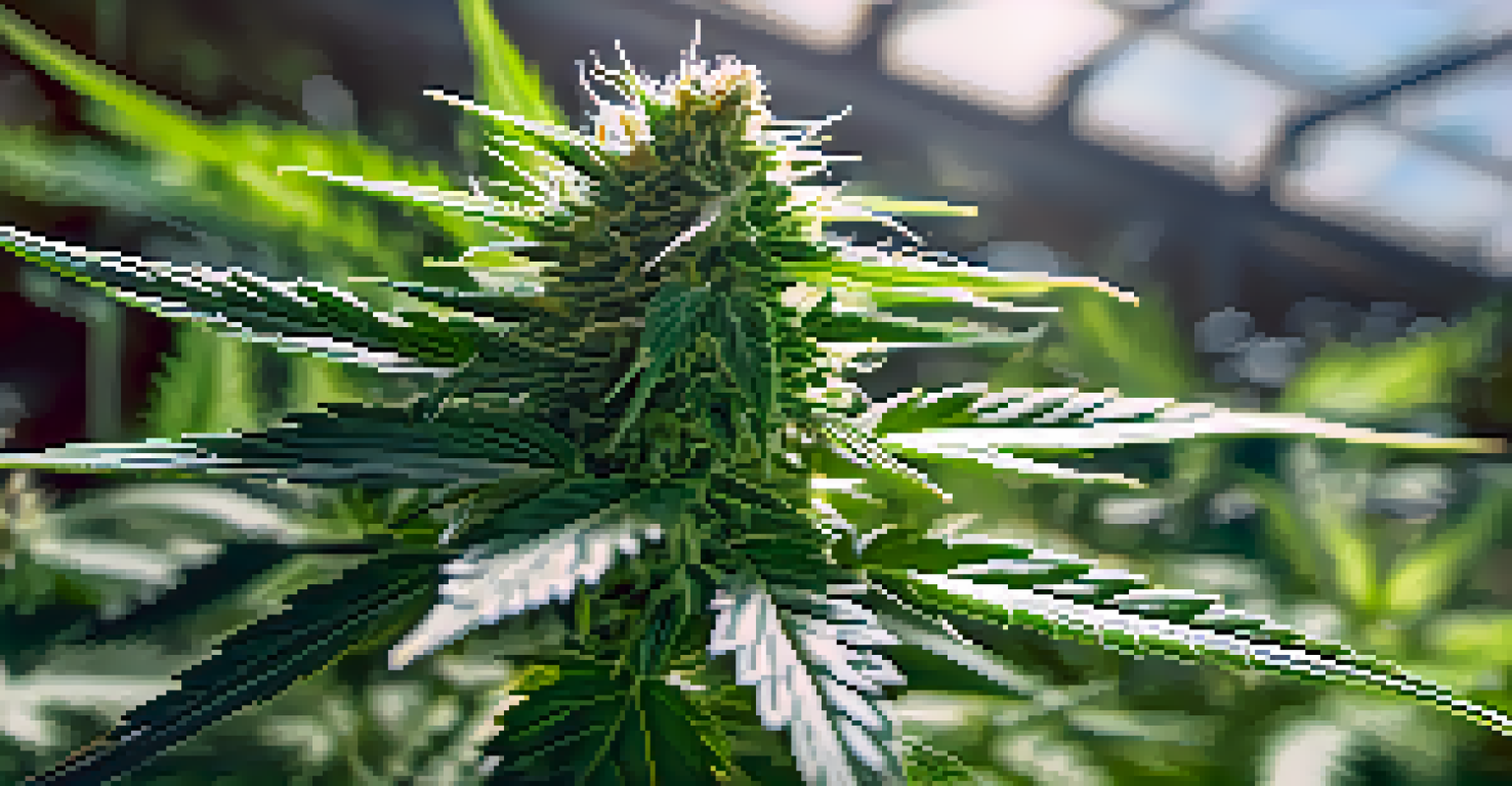Utilizing Data Analytics for Cannabis Marketing Insights

Understanding the Role of Data Analytics in Cannabis Marketing
Data analytics has become a game changer in the cannabis industry, allowing brands to make informed decisions based on real insights. By analyzing customer behavior and market trends, cannabis companies can tailor their marketing strategies to better resonate with their audience. This approach not only improves customer engagement but also boosts sales by targeting the right demographics at the right time.
Data is the new oil. It’s valuable, but if unrefined, it cannot really be used.
For instance, a cannabis dispensary can use data analytics to track purchasing patterns and identify peak buying times. This information can guide promotional efforts, such as special discounts during slow periods or targeted ads during high-traffic times. By leveraging this data, businesses can optimize their marketing tactics and improve overall performance.
Moreover, understanding the nuances of customer preferences through data helps in product development as well. Cannabis brands can discover which strains or products are most popular, enabling them to focus their resources on what truly appeals to their customers, ultimately leading to higher satisfaction and loyalty.
Harnessing Customer Data for Targeted Marketing Campaigns
One of the most effective ways to utilize data analytics in cannabis marketing is through customer segmentation. By categorizing customers based on demographics, purchasing behavior, and preferences, brands can create targeted campaigns that speak directly to each segment. This tailored approach not only increases engagement but also enhances the likelihood of conversion.

For example, a cannabis brand may identify a segment of health-conscious consumers who prefer edibles over traditional smoking methods. By crafting specific marketing messages that highlight the health benefits and quality ingredients of their edibles, the brand can effectively capture this audience's attention. This level of personalization can significantly increase brand loyalty and customer retention.
Data Analytics Boosts Marketing Success
Utilizing data analytics allows cannabis brands to make informed marketing decisions that resonate with their audience and drive sales.
Additionally, A/B testing can be employed to refine marketing strategies further. By analyzing different campaign variations, brands can determine which messaging resonates best with their target audience, ensuring that their marketing efforts are as effective as possible.
Using Social Media Analytics to Enhance Brand Presence
Social media platforms are treasure troves of data that can provide invaluable insights for cannabis marketing. By monitoring engagement metrics like likes, shares, and comments, brands can gauge how their content is performing and what resonates with their audience. This allows companies to adjust their strategies in real-time, ensuring they stay relevant and engaging.
Without data, you’re just another person with an opinion.
For instance, if a particular post about a new product receives a high level of engagement, a brand can analyze the factors that contributed to its success. Was it the imagery, the timing of the post, or the messaging? Understanding these elements can inform future content creation and help brands maintain a strong connection with their followers.
Moreover, staying attuned to trending topics within the cannabis community can also enhance brand visibility. By participating in relevant conversations or using popular hashtags, brands can increase their reach and attract new followers, ultimately contributing to a robust online presence.
Leveraging Website Analytics for Improved User Experience
Website analytics play a crucial role in understanding how customers interact with cannabis brands online. By analyzing metrics such as bounce rates, page views, and session duration, businesses can uncover areas of improvement for their websites. This data-driven approach allows brands to create a more user-friendly experience that encourages visitors to engage and convert.
For instance, if data shows high bounce rates on certain product pages, this may indicate that the content isn't resonating or that the page isn't visually appealing. By addressing these issues, brands can enhance their website, making it easier for customers to find what they're looking for and encouraging them to stay longer.
Customer Segmentation Enhances Engagement
By categorizing customers based on their preferences and behaviors, cannabis companies can create targeted marketing campaigns that increase conversion rates.
Additionally, implementing tools like heat maps can provide further insights into user behavior on a website. This allows brands to see which sections attract the most attention, helping them optimize their layouts and content to drive conversions.
Implementing Predictive Analytics for Future Trends
Predictive analytics is a powerful tool that can help cannabis brands anticipate market trends and consumer behavior. By analyzing historical data, businesses can make educated guesses about future purchasing patterns, allowing them to stay ahead of the competition. This proactive approach enables brands to adjust their marketing strategies before trends fully emerge.
For example, if data indicates a rising interest in CBD products, a cannabis brand can start developing a marketing campaign that highlights their CBD offerings. By positioning themselves early in the trend, they can capture market share and establish themselves as leaders in that niche.
Furthermore, predictive analytics can assist in inventory management. Understanding future demand allows brands to stock up on popular products, reducing the risk of running out and losing sales opportunities.
Monitoring Competitor Strategies with Data Analytics
Keeping an eye on competitors is essential in the cannabis industry, and data analytics can provide valuable insights into their strategies. By analyzing competitors' marketing campaigns, social media presence, and customer engagement, brands can identify best practices and areas for improvement within their own strategies. This competitive intelligence can be the difference between staying stagnant or thriving.
For instance, if a competitor is successfully engaging customers through a particular social media platform, a brand can investigate what types of content are performing well and adapt their strategy accordingly. This not only fosters innovation but also helps brands avoid making the same mistakes as others.
Compliance is Crucial for Data Use
Ensuring data collection and usage complies with legal regulations builds customer trust and protects cannabis brands from potential penalties.
Moreover, tools that track competitor pricing, promotions, and product offerings can inform a brand's pricing strategy, ensuring they remain competitive in the marketplace. Understanding what works for others can provide a roadmap for success.
The Importance of Compliance in Cannabis Data Analytics
In the cannabis industry, compliance is paramount, and data analytics must be employed with a clear understanding of legal regulations. Brands must ensure that their data collection and usage adhere to the laws governing cannabis marketing and consumer privacy. This not only protects the business but also builds trust with customers.
For example, a cannabis brand must be cautious when handling customer data, ensuring that personal information is securely stored and used only for intended purposes. Transparency in data practices can enhance customer loyalty and foster a positive brand image.

Additionally, staying updated on changing regulations is crucial. By implementing robust compliance measures within their data analytics processes, brands can avoid costly penalties and maintain their reputation in a rapidly evolving industry.
The Future of Cannabis Marketing with Data Analytics
As the cannabis industry continues to grow, the role of data analytics will undoubtedly become even more significant. Brands that embrace data-driven decision-making will be better positioned to adapt to changing consumer preferences and market dynamics. This forward-thinking approach is essential for long-term sustainability and success in the industry.
New technologies, such as AI and machine learning, are emerging to enhance data analytics capabilities. These advancements can provide even deeper insights into consumer behavior, allowing brands to refine their marketing strategies further and drive engagement.
Ultimately, the future of cannabis marketing lies in the ability to harness data effectively. By prioritizing data analytics, brands can unlock valuable insights that will not only enhance their marketing efforts but also contribute to the overall growth and acceptance of cannabis in society.